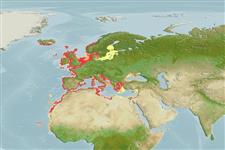Environment: milieu / climate zone / depth range / distribution range
Ekologi
laut; air tawar; payau dasar (demersal); katadromus (ruaya dari air tawar ke laut) (Ref. 46888); kisaran kedalaman 2 - 15 m (Ref. 130217). Subtropical; 65°N - 12°N, 24°W - 36°E
Eastern Atlantic: Scandinavia and Iceland (Ref. 4537) south to Senegal and Cape Verde. Also Mediterranean Sea; southwestern Black Sea (Ref. 2058).
Length at first maturity / Size / Weight / umur
Maturity: Lm 29.5 range ? - ? cm
Max length : 75.0 cm SL jantan/; (Ref. 35388); common length : 32.0 cm SL jantan/; (Ref. 7399); Berat maksimum terpublikasi: 4.5 kg (Ref. 35388); Umur maksimum dilaporkan: 25 Tahun (Ref. 35388)
Duri punggung (Keseluruhan (total)) : 5; duri punggung lunak (Keseluruhan (total)) : 7 - 9; Duri dubur: 3; Sirip dubur lunak: 8 - 9.
Adults are found inshore in schools, frequently entering brackish lagoons and freshwater (Ref. 30578). They migrate occasionally tending to move northward in summer-time as temperatures rise. Females are larger than males (Ref. 59043). Adults feed mainly on benthic diatoms, epiphytic algae, small invertebrates and detritus (Ref. 2804), juveniles only feed on zooplankton (Ref. 59043). Oviparous (Ref. 205). Reproduction occurs in the sea during winter (Ref. 30578). Eggs and larvae pelagic. Utilized as a food fish (Ref. 4645).
Juveniles around 2.0 cm SL move to coastal lagoons and estuaries in April-June and return to sea in summer (Ref. 59043).
Thomson, J.M., 1986. Mugilidae. p. 344-349. In J. Daget, J.-P. Gosse and D.F.E. Thys van den Audenaerde (eds.) Check-list of the freshwater fishes of Africa (CLOFFA). ISNB, Brussels, MRAC; Tervuren; and ORSTOM, Paris. Vol. 2. (Ref. 3573)
Status IUCN Red List (Ref. 130435)
ancaman kepada manusia
Harmless
penggunaan manusia
Perikanan: komersial; Ikan buruan: ya; Akuarium: Akuarium publik
Alat, peralatan
laporan khas
muat turun XML
Sumber internet
Estimates based on models
Preferred temperature (Ref.
123201): 8.8 - 20.1, mean 11 °C (based on 420 cells).
Phylogenetic diversity index (Ref.
82804): PD
50 = 0.5005 [Uniqueness, from 0.5 = low to 2.0 = high].
Bayesian length-weight: a=0.00724 (0.00559 - 0.00939), b=3.11 (3.03 - 3.19), in cm total length, based on LWR estimates for this species (Ref.
93245).
Trophic level (Ref.
69278): 2.6 ±0.32 se; based on food items.
Daya lenting (Ref.
120179): sedang, Waktu penggandaan populasi minimum 1.4 - 4.4 tahun (K=0.12-0.17; tm=3; tmax=25).
Fishing Vulnerability (Ref.
59153): High vulnerability (63 of 100).
Climate Vulnerability (Ref.
125649): Moderate to high vulnerability (51 of 100).
Nutrients (Ref.
124155): Calcium = 39.2 [10.7, 335.3] mg/100g; Iron = 0.623 [0.303, 1.151] mg/100g; Protein = 17.9 [16.5, 19.5] %; Omega3 = 0.399 [0.166, 0.964] g/100g; Selenium = 9.58 [3.60, 24.88] μg/100g; VitaminA = 7.52 [2.12, 24.93] μg/100g; Zinc = 0.571 [0.342, 0.951] mg/100g (wet weight); based on
nutrient studies.
